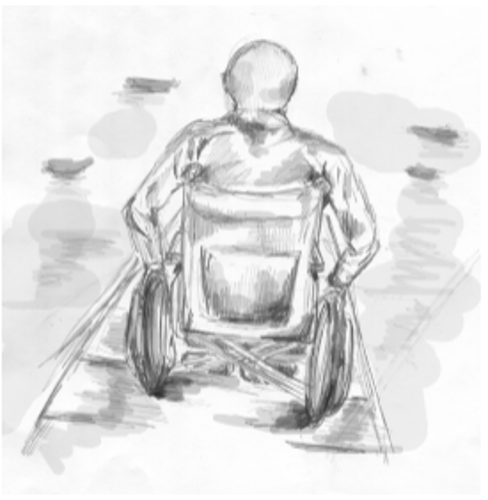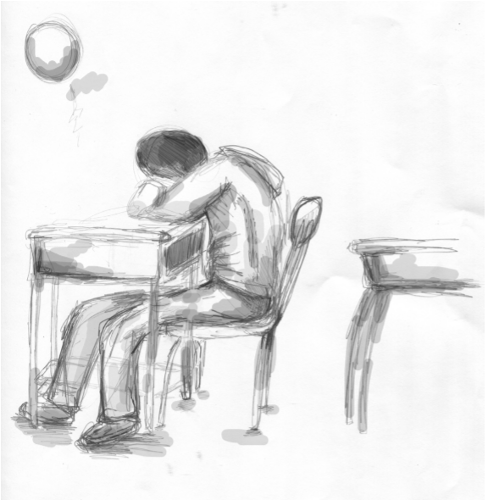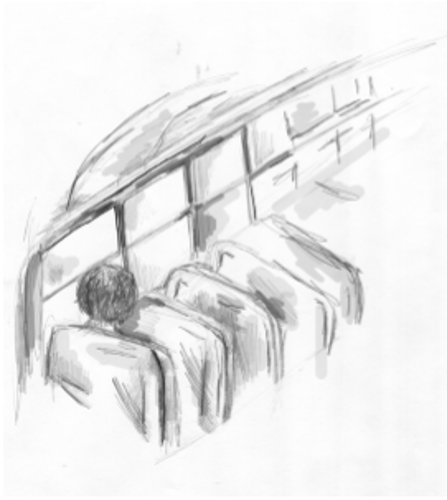Aching on the Periphery of Pain
You and I are alive and thus we have not died. But have you ever been in pain?
♦
I was chatting with a friend by the bleachers when the shooting began at the high school athletic field where I recently found myself during a dream. The concrete area was spacious, but it was fenced off. The rhythm of shots bounced off the fences: there was nowhere to go. As the tempo grew, other young people were climbing and falling, or scouring in corners. I thought them shortsighted and scattered — easy targets. I would be tactful. I would survive. I grabbed my younger sister, who was standing nearby, clutched her to the point of her immobilization, and ran, hid under a set of bleachers with enough room for two bodies, hers and mine. I felt canny. He would never find us here.
Once he did, I looked at the bore of the rifle he pointed directly at my face and imagined it delivering my life’s end. I awoke just as he changed his mind and shot someone else. I do not know where that victim was hit, nor how he or she fared. Conflict and terrorism: 150,457 dead *
♦
My father walked into the bathroom around 11:30 p.m. on the night seven years ago that he fell and damaged his brain. Lung and bone cancers had for five years worn him, but it was a stroke on this night that started his end. A leased hospital cot had to be placed in his bedroom to cradle his body. Though it was once strong-limbed — that of an athlete, family man, and full-time surgeon — now it was falling apart. After the fall, his figure was feeble and gaunt, and his cancerous bones were failing. My father’s body was distressed as he progressively lost his speech, cognition, and bodily functions. His eyes used to be intense, emboldened by a lifetime of performing intricate surgeries and spotting bank clients’ lies; now, he could hardly keep them open, and in those moments when he could, they squinted at you. His mouth, used to sharing jokes and emphasizing words, now creaked open just slightly whenever the nurses tried to feed him blended food that dripped out of the corners of his lips. His legs, those of a runner and swimmer, now laid limply on his wheelchair. He would attempt sometimes with all his might to stand. But with all his frail muscles straining, he would fall, his wheelchair there to catch him.
One rough night in June, his breathing was more broken than usual and his energy waning. My mother suggested to my sister and me that while our father slept in his cot, we sleep with her on their bed, a king-sized comfort from my father’s past life. At around 2:00 a.m., as I slept, the nurse let my mother know it was time. I do not remember my mother waking me and walking me to my own bedroom. Better that way. I slept soundly as twilight grew and his life faded. Falls: 678,458 dead
♦
In a stairwell about 20 meters away from my high school English classroom, a 17-year-old Black junior was caught with an empty bag containing marijuana residue. Suspended for 10 days from our Miami public high school, the student went to visit his father in Sanford, Florida, where he lived with his fiancée. While the couple were out for dinner on the night of Sunday, February 26, 2012, the young man stayed home playing video games. At some point in the evening, he walked to a convenience store, where at 6:24 p.m., he bought some candy and iced tea. At 6:54 p.m., he began talking on the phone with his friend Rachel. At 7:09 p.m., while the young man was still headed home, a Hispanic man, the neighborhood watch coordinator for the gated community, called the Sanford Police Department to report “a real suspicious guy.” The watchman told the dispatcher he was frustrated that “these fucking punks” walked around his neighborhood aimlessly. He was concerned that “these assholes, they always get away.” The “punk” told Rachel on the phone that he saw a man tagging him in a truck. He began to run. At 7:11 p.m., the watchman told the dispatcher that the young man was running, and that he was going to follow him. The dispatcher told the watchman: “OK, we don’t need you to do that.” The watchman disobeyed. At 7:13 p.m., the watchman ended his call to the dispatcher, and at 7:16 p.m., the call between the “punk” and Rachel was dropped. At 7:17 p.m., the watchman shot the young man in the chest, 65 meters from his townhouse. At 7:30 p.m., a paramedic pronounced Trayvon Martin dead.
At school, Trayvon’s death was everywhere. It was in the hallways where some students whispered and others stayed to themselves. It was on the news, where over the next three years of my schooling, the court case dragged on, George Zimmerman was acquitted on self-defense grounds, and Trayvon’s name rightly pervaded. It was on the intercom, loud during the moments of silence led by the principal to be broken only by her crackling sobs. Everywhere, gossiped about when the same principal received dozens of death threats blaming her for Trayvon’s suspension and therefore death. Trayvon’s death was on the tidy sidewalk demonstrations and weak walkouts—results of students wanting to do something but unsure how. It was everywhere when then-President Obama shared that Trayvon “could have been my son.” Everywhere. Trayvon had died, and it was everywhere. Executions and police conflict: 4,378 dead
♦
Anyeli, our Colombian bus driver, was a joyous and gushing person, her permanent makeup lighting up her face as she gossiped with her grade-school-aged passengers in Spanish — her only fluent language — the whole 10-minute ride to school. This is the Anyeli my sister and I expected to find as we opened the door of the van one Friday morning in 2008, when I was 11. Instead, we found her sobbing into the phone at the driver’s seat and waving around three moist tissues. When we opened the door, she paused her conversation, turned to us, and asked that we return home and ask our parents for money. The night before, she said, her close friend’s 10-yearold son, Esteban, had been shot dead. Her friend was distraught, so Anyeli was overseeing the funeral arrangements, and every penny helped.
At home, we sputtered to our parents the jumbled story we were just told. They gave us $25 cash to return to Anyeli, but the dollar amount did not please her very much. “What good will this do?” she said in Spanish on the phone.
That night I thought of Esteban. He was younger than me and attended a different school nearby, but he sometimes joined our afternoon route. He would sit by the window, quietly, his withdrawn and soft eyes staring out, his brown skin smooth and pure. Nothing about Esteban suggested a story. Much less one of a violent household where Dad threatened Mom with a barbell while she was pregnant and once hit her newborn in the head, where Mom verbally abused Dad, and where both parents lived embroiled in courtroom battles over their children.
In the weeks that followed, local news outlets could tell me only so much about Esteban’s death. But Anyeli was always ahead; every morning ride, she delivered the latest detail. Slowly, her gossip built the story: Esteban’s father broke into the house where Esteban lived with his mother, and Esteban ran. He hid in his bathroom. The door was broken down. Esteban was shot in that bathroom. At 3:45 p.m. his mother found his body in that bathroom. Eleven hours later, at 1:50 a.m., police found his father: dead, too. He had shot himself in his brown Jeep, parked in the back of a Tony Roma’s.
Esteban’s mother for a while avoided the scene of the murder. She stayed instead in Anyeli’s home. Anyeli told us that every morning, while we were on our way to school, Esteban’s mother slept in. I imagined her curled on a couch, holding her newborn in her arms, weeping. Interpersonal violence: 390,793 dead. Self-harm: 817,147 dead
♦
“First they came for the Socialists, and I did not speak out —
Because I was not a Socialist.
Then they came for the Trade Unionists, and I did not speak out —
Because I was not a Trade Unionist.
Then they came for the Jews, and I did not speak out —
Because I was not a Jew.
Then they came for me — and there was no one left to speak for me.” **
♦
Should you suffer an injury, your body would instantly initiate an inflammatory response. What this response would look like depends on the type, location, and severity of your hurt.
In the case, for example, that you are stuck in a wildfire or fumble with the oven, your contact with temperatures above 111oF would lead the proteins in your skin cells to begin to break down. A burn like this one would elicit an inflammatory response that would lead your capillaries to leak fluid, thereby inhibiting your circulation and restricting blood flow to organs such as your kidneys and heart.
If your skin remains intact but you nevertheless sustain trauma from, say, a car crash forcing your head into a windshield, the inflammatory response would look different. Your brain would not keep up with your head’s rapid movement, and so it would hit your skull, hard. Your brain tissue would bruise, blood vessels tearing, and your neurons’ axons would stretch (and sometimes break), interrupting connections vital to everyday functions from speech to movement. Trauma might not affect your brain, but another organ. If you are, instead, struck by an assailant anywhere else on your body, such as your abdomen or crutch, fluid could build up inside, or maybe outside, your point of injury, causing it to swell. This in turn would potentially lead to a local fever or, in a worse case, the impairment of that organ’s function. So, it is better to identify and diagnose this with the help of the experts from Total Health and Rehab in order to avoid complications that would severely affect one’s healing process.
Basically, your inflammatory response to any kind of injuries would be different in all situations. For example, if you experienced blood loss from a gunshot wound or other type of gash. Here, trauma’s “triad of death” — the positive feedback loop of hypothermia, coagulopathy, and acidosis — would take over your system. Because of blood loss, your oxygen levels would subside, leading your body to cool and likely enter hypothermia. The diminishing temperatures would prevent your blood from coagulating, or clotting — the self-repair mechanism that prevents further blood loss. Your blood flow would remain unimpeded, and your oxygen levels would keep diminishing, but, naturally, your body would continue to burn glucose for energy. This would represent your body’s last-ditch effort to survive. And the effort would likely fail. It would fail because you need oxygen to burn glucose, and — remember — your oxygen levels are low. Your body’s inefficient glucose-burning would only make things worse, leading to the release and buildup of acids that would further diminish your oxygen levels. The triad, uninterrupted as it often goes, would kill you. Injuries, all types: 4,610,990 dead
♦
Will hurricane winds need to launch your roof onto you as you sleep? Will a landslide need to bury you? Exposure to forces of nature: 7,058 dead. Will your city need to be overtaken by smog? Does your carbon monoxide alarm need to miss a gas leak? Poisonings: 57,076 dead. Will wildfires need to overtake your state, too? Fire, heat, and hot substances: 132,084 dead. Must you capsize while escaping your war-torn home on an overloaded vessel? Drowning: 302,931 dead. Does your sedan need to tackle a ditch and skid off an overpass? Road injuries: 1,342,284 dead
♦
Must you bleed to ache? Who will be left to care if it is those who die who care? Why are those who advocate mostly those who have been hurt? How far does your empathy go? Will it take your own suffering for you to shout “enough?” Can you care about preventable injuries if you have not experienced one yourself? What sight will change you? What feeling will disturb you? What violence must you witness? Who must die? A parent? Child? Lover? You? Must you die?
You have not died. But have you ever been in pain?
*Global death tolls for 2016 are based on data from the Global Burden of Disease Study.
**Martin Niemöller, a Lutheran minister, writing on the dangers of apathy shortly after surviving eight years in the Holocaust’s concentration camps, where he was sent for opposing Hitler’s regime. His words, which are on display at the United States Holocaust Memorial Museum, have been borrowed and adapted by protest movements over time.
Dan Sicorsky ’19 studies in the College of Arts & Sciences. He can be reached at dan.sicorsky@wustl.edu.



1 Comment
Join the discussion and tell us your opinion.
There is a young Allen Ginsberg in you, Mr. Sicorsky.